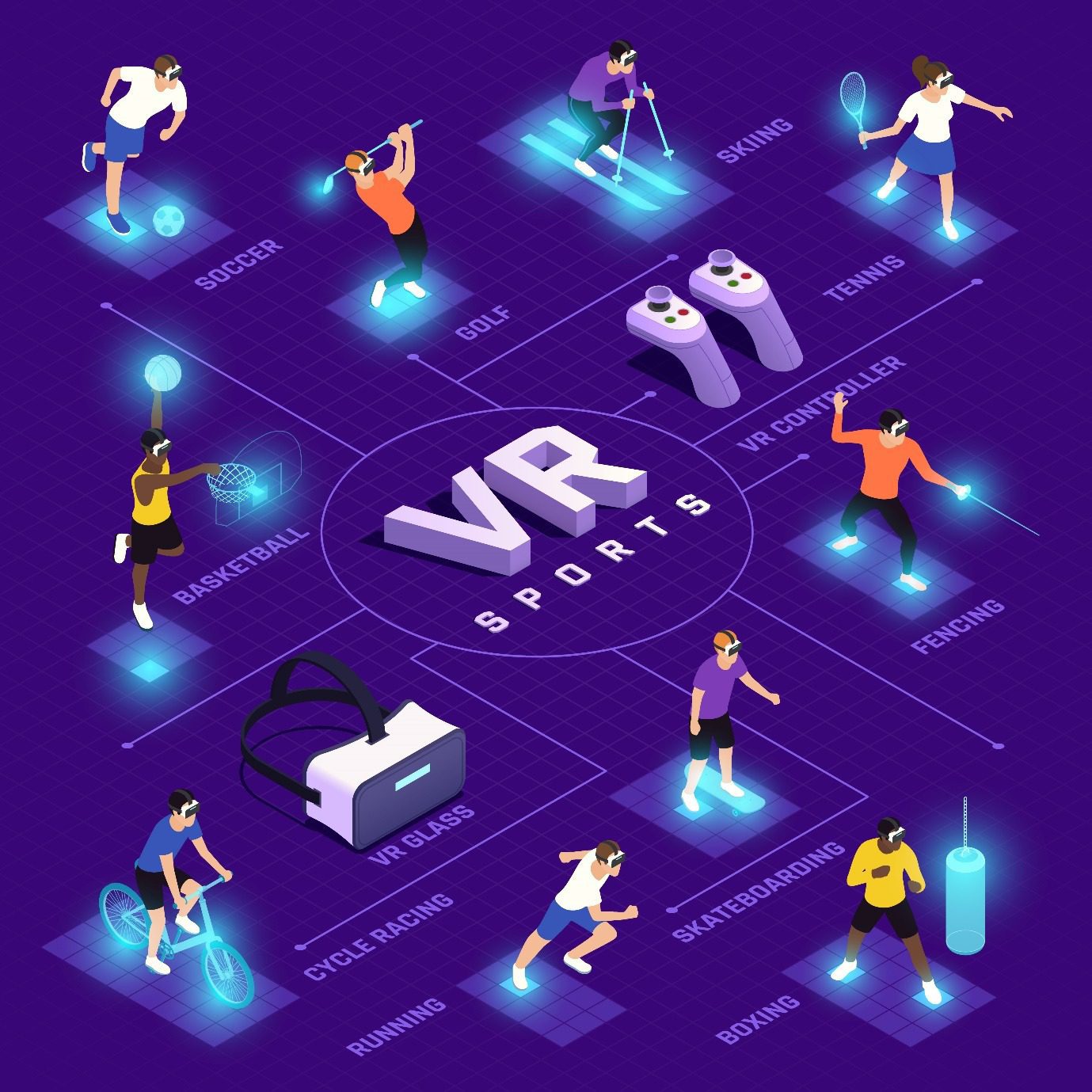Virtual reality (VR) and augmented reality (AR) in sports can benefit athletes and spectators. When combined, virtual reality (VR) and augmented reality (AR) can produce convincing simulations of real-world situations. Both have advantages and disadvantages and can assist athletes, coaches, and spectators. This piece examines how various stakeholders and specialists have succeeded with the sports industry’s virtual and augmented reality applications. Find the best Flutter Application Development Service for your next project.

Virtual Reality for Instruction
Virtual reality (VR) can be utilized to build realistic and interactive training environments to prepare athletes for competition better. Virtual reality (VR) technology allows athletes to train for and receive immediate feedback on high-stakes situations like penalty kicks, free throws, and corner kicks. Virtual reality can also aid coaches in analyzing their players’ actions, reactions, and strategies to guide their teams better. Best practices for using virtual reality (VR) in training include:
- Selecting gear and software appropriate to the sport and training objectives.
- Ensuring users are safe and comfortable.
- Incorporating VR with other data sources and tools.
- Assessing the results and effects of VR training.
Assistive Technology in Education
By adding digital information and feedback to the training environment, AR can help athletes learn and be more motivated. Using augmented reality, athletes can see how their trajectories, angles, speeds, or lengths stack up against competitors. Coaches can use augmented reality to connect with their teams better, keep tabs on their performance, and adjust as needed.
What Places Make Use of It?
Augmented reality combines a user’s real-world surroundings with a computer-generated overlay. There are vast applications for this breakthrough. The landscape of sports is currently shifting because of it. Top Flutter Application Development Service in India can be of great use to you.
1. Improving the Quality of Life
Going to a stadium to see a game or match live is an experience that should be noticed. However, it lacks some features that may be enjoyed on TV, such as contextual information about the players and the game’s history.
Now we can use augmented reality. It has the potential to bridge the chasm between the actual and the virtual, even during a live game. Players’ reactions to in-game events can be boosted by incorporating interactive content.
2. Broadcasting
Not only may transmission be significantly improved, but so can the experience of watching a match. To be specific, it has the potential to increase fun and engagement. A live match can be enhanced with the addition of digital content. It can also aid in visualizing ball trajectories through simulated lines. It makes each game more interesting so that you can’t take your eyes off the screen.
3. In-Game App Functionality
More people are likely to download an app with augmented reality features. This is borne out by the experiences of NFL teams, for instance.
4. The NFL Fan’s “Idol”
The sports industry constantly seeks innovative methods to provide fans more engaging content. Luckily, AR has the solution. For instance, INDE’s augmented reality experience lets fans meet their favorite NFL players using a specialized colossal screen. Toss in JuJu Smith-Schuster and Antonio Brown, too.
INDE x Pizza Hut’s Super Bowl LIII augmented reality experience featured Antonio Brown and JuJu Smith-Schuster.
Fans might pick a dance move and interact with the player in a 3D environment. The user’s surroundings were blended with a computer-generated image of the athletes. This is an excellent example of the power of augmented reality and how it can help bring audiences closer to their favorite performers.
5. Whether to Wow or Frustrate a Footballer
INDE collaborated with Adidas on a similar idea, allowing Tango League players to showcase their football skills. Football great Marcelo Vieira of Brazil and Real Madrid was brought to life, superimposed over the user’s environment in real-time.
Immersive VR for the Fans
With the help of augmented and virtual reality, sports spectators may engage with the action as it unfolds in real-time. Fans can feel the excitement of the game from the perspective of a player or a referee with the use of augmented reality (AR) and virtual reality (VR). Virtual reality games and challenges can also be developed using AR/VR, bringing fans closer to the action in real time.
For instance, the National Football League has collaborated with Google to develop a VR app for its supporters. Fans may receive a 360-degree perspective of the action and engage with the game in real-time using Google Cardboard to enter a virtual reality experience.
Fan Interaction Using Augmented Reality
An augmented reality fan experience can be made with AR technology, allowing spectators to participate in the action as it unfolds. Fans can learn more about the game using augmented reality technology, such as current stats and player profiles. AR can also be utilized to make games and challenges that let spectators participate in the action in real-time.
Brain Injury Evaluation:
- Early detection is crucial for the health and safety of athletes suffering from concussions, a common injury in sports. The symptoms of a concussion can be evaluated, and the injury diagnosed using augmented and virtual reality technology.
- For instance, the eye-tracking technology firm EyeGuide has created a virtual reality-based concussion evaluation tool to evaluate an athlete’s equilibrium and reflexes after a possible concussion. The instrument is sensitive enough to pick up on even the most minute alterations in an athlete’s eye movements, which may indicate a concussion. The exam can be given on the sidelines of a game or practice and only takes a few minutes to finish.
Protecting from harm:
- The use of AR/VR can also help reduce the number of sports-related injuries. Athletes can prevent injuries by practicing game situations and maneuvers in a simulated environment. As an added benefit, AR/VR can mimic rehabilitation workouts, helping athletes return to the game faster after an injury.
- Soccer players, for instance, can utilize augmented and virtual reality (AR/VR) to practice kicking and landing in a safe environment, reducing the risk of ankle injuries. By watching their motions in real time, athletes may spot flaws and work to fix them.

Rehab and bodily therapy:
- The application of AR/VR in sports medicine and rehabilitation is also on the rise. Athletes can speed up their recovery from injuries and boost their flexibility and strength by imitating activities and movements.
- For instance, athletes with knee issues can use the MindMotion Pro system, which employs virtual reality to deliver immersive therapy. Sensors monitor the athlete’s performance and transmit that data in real-time so they may make the necessary adjustments to their form. Virtual reality can also be used in treatment to lessen patients’ perceptions of pain and stress.
Instruction and Practice:
- Athletes also use AR/VR to train for competition and boost their performance. By recreating game conditions and drills, athletes may hone their skills and make better decisions under pressure.
- To hone defensive posture and quickness, AR/VR can be utilized to recreate game situations in sports like basketball. Additionally, athletes can use AR/VR to practice free-throw shooting in a realistic environment away from the pressures of a game setting.
Conclusion
The sports business is only one of many that is undergoing radical change. As a result, several promising new avenues for doing business in augmented reality have opened up. Augmented reality is changing how we do everything, from going to the theater to how we shop. There are a variety of businesses that could benefit from this opportunity. Flutter Application Development must be chosen for your upcoming project.









